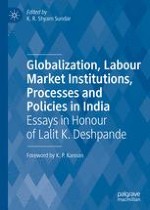2019 | OriginalPaper | Buchkapitel
4. Labour Regulations and Informalization of Industrial Labour in India
verfasst von : Bishwanath Goldar, Suresh Chand Aggarwal
Erschienen in: Globalization, Labour Market Institutions, Processes and Policies in India
Verlag: Springer Nature Singapore
Aktivieren Sie unsere intelligente Suche, um passende Fachinhalte oder Patente zu finden.
Wählen Sie Textabschnitte aus um mit Künstlicher Intelligenz passenden Patente zu finden. powered by
Markieren Sie Textabschnitte, um KI-gestützt weitere passende Inhalte zu finden. powered by
